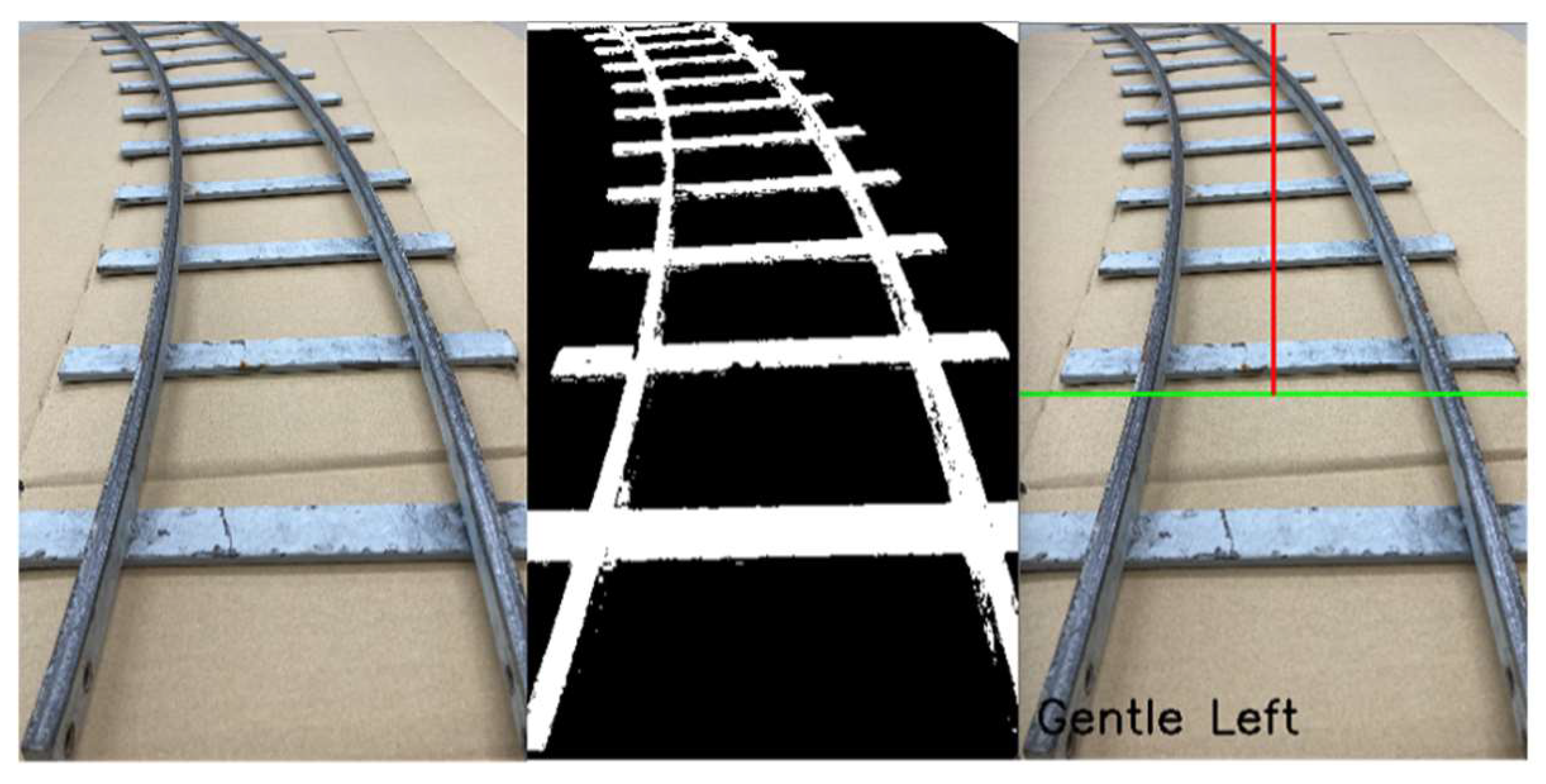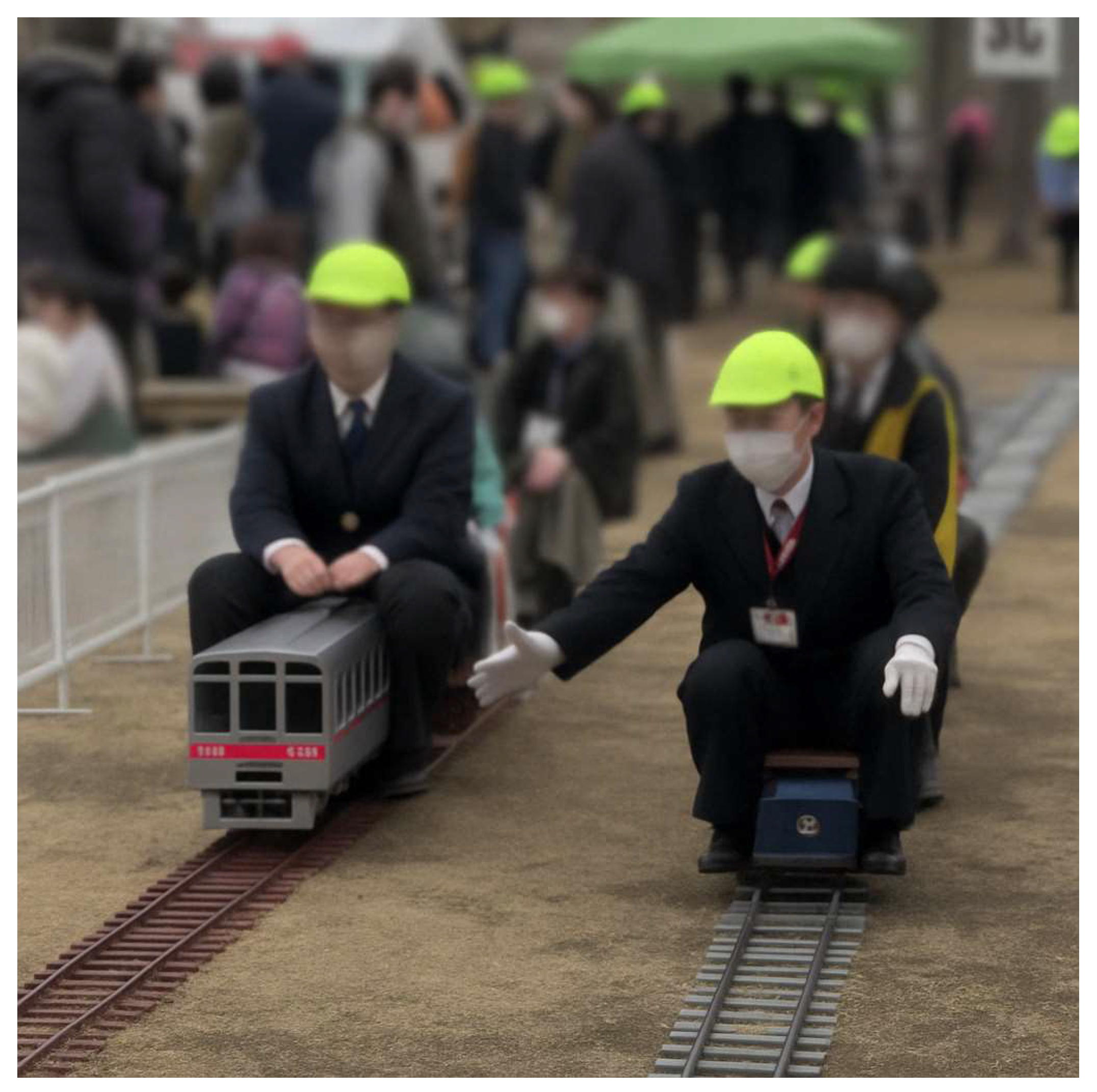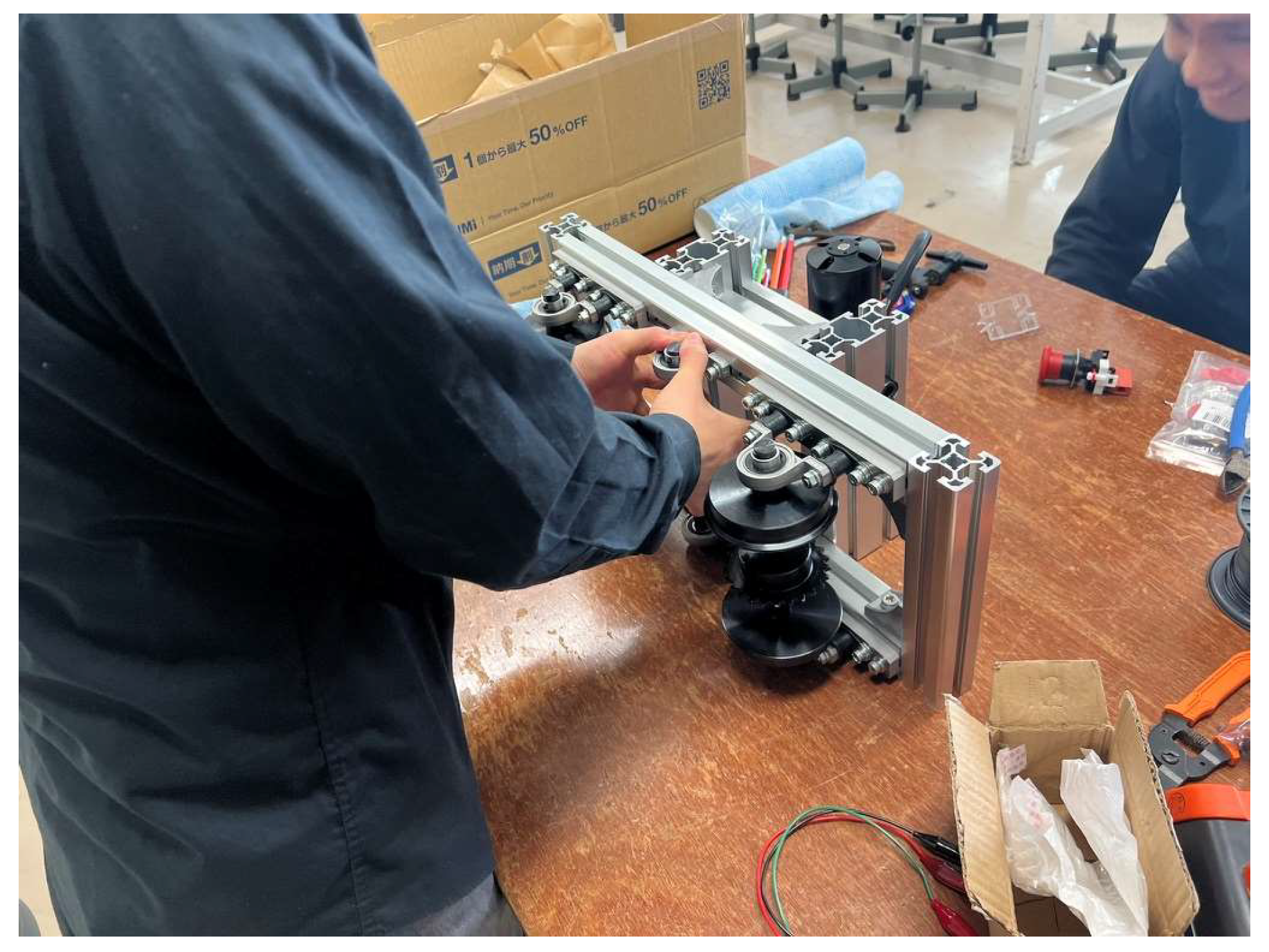Community-Integrated Project-Based Learning for Interdisciplinary Engineering Education: A Mechatronics Case Study of a Rideable 5-Inch Gauge Railway
Abstract
1. Introduction
2. Theoretical Background
2.1. Overview
2.2. Design-Based and Experiential Learning Foundations
2.3. Situated and Scaffolded Learning
2.4. Self-Regulated Learning
2.5. Constructive Alignment
3. Context and Project Overview
3.1. Educational Setting
3.2. Project Objectives
3.3. Technical Overview
- Mechanical design: A steel chassis and wheel assembly modeled in SolidWorks (2024) CAD software (see Figure 2)
- Motor control: A brushless DC motor (3 Nm) connected via a 1:13 gear ratio and controlled with an off-the-shelf driver
- Power unit: A modular lead-acid battery array with swappable units
3.4. Collaborative Roles
- Mechanical Lead: Responsible for system architecture and CAD modeling (SolidWorks)
- Circuit Lead: Managed wiring, motor control integration, and procurement
- Vision Lead: Developed image processing and system-level integration in Python
4. Methodology
4.1. Research Design
4.2. Participants and Course Implementation
4.3. Data Collection Instruments
- Post-course questionnaire: A 5-item Likert-scale survey, supplemented by two open-ended reflection prompts.
- Instructor observations: Field notes recorded during prototyping sessions and final presentations.
- Student artifacts: CAD models, Python code, and subsystem integration designs.
- Communication logs: Archived records capturing discussions, planning, and problem-solving behavior.
4.4. Data Analysis
5. Results and Analysis
5.1. Quantitative Survey Results
5.2. Qualitative Reflections
5.3. TEAMS Communication Analysis
5.4. Observational Evidence (Photographs)
- Students actively assembling and testing mechanical components
- Clear evidence of peer-to-peer instruction and task coordination
- Final system deployment in an authentic community setting
5.5. Theoretical Alignment
6. Discussion
6.1. Educational Implications and Theoretical Contributions
6.2. Limitations and Future Directions
7. Conclusions
Funding
Institutional Review Board Statement
Informed Consent Statement
Data Availability Statement
Acknowledgments
Conflicts of Interest
Abbreviations
| PBL | Project-Based Learning |
| SRL | Self-Regulated Learning |
| CAD | Computer-Aided Design |
| KOSEN | National Institute of Technology (Japan) |
Appendix A. Student Questionnaire
Appendix A.1. Questionnaire Items (English Translation)
Appendix A.2. Detailed Questionnaire Results
| Question | Mean | Standard Deviation | Mode |
|---|---|---|---|
| Q1 | 4.67 | 0.58 | 5 |
| Q2 | 5.00 | 0.00 | 5 |
| Q3 | 4.33 | 0.58 | 4 |
| Q4 | 5.00 | 0.00 | 5 |
| Q5 | 4.67 | 0.58 | 5 |
| Student | Q1 | Q2 | Q3 | Q4 | Q5 |
|---|---|---|---|---|---|
| Student A | 5 | 5 | 4 | 5 | 5 |
| Student B | 4 | 5 | 4 | 5 | 4 |
| Student C | 5 | 5 | 5 | 5 | 5 |
| Student | Comment |
|---|---|
| A | (JA): カメラの調整で試行錯誤して学ぶことが多かった。難しかったが達成感があった。 (EN): I learned a lot by trial and error during camera tuning. It was difficult but rewarding. |
| B | (JA): バッテリーと配線の管理がリアルなエンジニアリング体験になった。 (EN): Managing the battery and wiring felt like a real engineering experience. |
| C | (JA): 部品が遅れてスケジュールを立て直したのは現実的だった。 (EN): Having to revise the schedule due to delayed parts felt realistic. |
Appendix B. Communication on Production Logistics
| Date | Speaker | Message (English Translation) |
|---|---|---|
| Nov 23 | Teacher | I will place the order after contacting the school, so please wait a little. |
| Nov 27 | Student A | The sprocket has arrived, but the other parts are still pending. |
| Dec 17 | Teacher | Have the aluminum materials arrived yet? I passed the drawings to the workshop to prepare the data. |
| Jan 8 | Student B | The parts have arrived. We will start assembly after class on the 25th, as planned. |
| Jan 15 | Teacher | I’ll order the spring washers, just in case. |
| Jan 15 | Student A | Please wait before placing the order. Some parts are missing. I’ll prepare a list. |
| Jan 15 | Teacher | Understood. Let me know when the missing items are confirmed. |
| Jan 15 | Student A | I’ve created a list of additional items. Please proceed with the order. |
Appendix C. Source Code for Line Detection
Appendix D. Request for Participation and Informed Consent
References
- Andrade, H. G. (2005). Teaching with rubrics: The good, the bad, and the ugly. College Teaching, 53(1), 27–31. [Google Scholar] [CrossRef]
- Biggs, J. (1996). Enhancing teaching through constructive alignment. Higher Education, 32(3), 347–364. [Google Scholar] [CrossRef]
- Biggs, J. (2014). Constructive alignment in university teaching. HERDSA Review of Higher Education, 1, 5–22. Available online: https://www.herdsa.org.au/herdsa-review-higher-education-vol-1/5-22 (accessed on 4 April 2025).
- Bolick, M. A., Thomassen, M., Apland, J., Spencer, O., Nicole, F., Tran, S. K. N., Voigt, M., & Lazar, K. B. (2024). Project-based learning in interdisciplinary spaces: A case study in Norway and the United States. Education Sciences, 14(8), 866. [Google Scholar] [CrossRef]
- Brundiers, K., & Wiek, A. (2013). Do we teach what we preach? An international comparison of problem- and project-based learning courses in sustainability. Sustainability, 5(4), 1725–1746. [Google Scholar] [CrossRef]
- Brundiers, K., Wiek, A., & Redman, C. L. (2010). Real-world learning opportunities in sustainability: From classroom into the real world. International Journal of Sustainability in Higher Education, 11(4), 308–324. [Google Scholar] [CrossRef]
- English, M. C., & Kitsantas, A. (2013). Supporting student self-regulated learning in problem- and project-based learning. Interdisciplinary Journal of Problem-Based Learning, 7(2), 128–150. [Google Scholar] [CrossRef]
- Gómez Puente, S. M., van Eijck, M., & Jochems, W. (2013). Empirical validation of characteristics of design-based learning in higher education. International Journal of Engineering Education, 29(2), 491–503. [Google Scholar]
- Halverson, E. R., & Sheridan, K. (2014). The maker movement in education. Harvard Educational Review, 84(4), 495–504. [Google Scholar] [CrossRef]
- Hidayat, H., Anwar, M., Harmanto, D., Dewi, F. K., Orji, C. T., & Isa, M. R. M. (2024). Two decades of project-based learning in engineering education: A 21-year meta-analysis. TEM Journal, 13(4), 3514–3525. [Google Scholar] [CrossRef]
- Hmelo-Silver, C. E. (2004). Problem-based learning: What and how do students learn? Educational Psychology Review, 16(3), 235–266. [Google Scholar] [CrossRef]
- Ifenthaler, D., & Yau, J. Y.-K. (2020). Utilising learning analytics to support study success in higher education: A systematic review. Educational Technology Research and Development, 68(4), 1961–1990. [Google Scholar] [CrossRef]
- Kokotsaki, D., Menzies, V., & Wiggins, A. (2016). Project-based learning: A review of the literature. Improving Schools, 19(3), 267–277. [Google Scholar] [CrossRef]
- Kolb, D. A. (1984). Experimental learning: Experience as the source of learning and development. Prentice-Hall. [Google Scholar]
- Kondo, A., Hayashi, H., & Toyoshi, T. (2023). Project-based learning of mechanical design utilizing CAE structural analyses. Education Sciences, 13(7), 687. [Google Scholar] [CrossRef]
- Krajcik, J. S., & Shin, N. (2014). Project-based learning. In R. K. Sawyer (Ed.), The Cambridge handbook of the learning sciences (2nd ed., pp. 275–297). Cambridge University Press. [Google Scholar] [CrossRef]
- Lavado-Anguera, S., Velasco-Quintana, P.-J., & Terrón-López, M.-J. (2024). Project-based learning (PBL) as an experiential pedagogical methodology in engineering education: A review of the literature. Education Sciences, 14(6), 617. [Google Scholar] [CrossRef]
- Lave, J., & Wenger, E. (1991). Situated learning: Legitimate peripheral participation (1st ed.). Cambridge University Press. [Google Scholar] [CrossRef]
- López Carrillo, M. D., Calonge García, A., & Lebrón Moreno, J. A. (2024). Self-regulation of student learning in a STEAM project. Education Sciences, 14(6), 579. [Google Scholar] [CrossRef]
- Mills, J. E., & Treagust, D. F. (2003). Engineering education—Is problem-based or project-based learning the answer? Australasian Journal of Engineering Education, 3(2), 2–16. [Google Scholar]
- Mota, F. B., Cabral, B. P., Braga, L. A. M., & Lopes, R. M. (2025). Mapping the global research on project-based learning: A bibliometric and network analysis (2014–2024). Frontiers in Education, 10, 1522694. [Google Scholar] [CrossRef]
- National Institute of Technology. (2024). About KOSEN. National Institute of Technology. Available online: https://www.kosen-k.go.jp/english/index.html (accessed on 4 April 2025).
- OECD. (2018). Equity in education: Breaking down barriers to social mobility. OECD. [Google Scholar] [CrossRef]
- Panadero, E., Jonsson, A., Pinedo, L., & Fernández-Castilla, B. (2023). Effects of rubrics on academic performance, self-regulated learning, and self-efficacy: A meta-analytic review. Educational Psychology Review, 35(4), 113. [Google Scholar] [CrossRef]
- Prince, M. J., & Felder, R. M. (2006). Inductive teaching and learning methods: Definitions, comparisons, and research bases. Journal of Engineering Education, 95(2), 123–138. [Google Scholar] [CrossRef]
- Ramírez De Dampierre, M., Gaya-López, M. C., & Lara-Bercial, P. J. (2024). Evaluation of the implementation of project-based-learning in engineering programs: A review of the literature. Education Sciences, 14(10), 1107. [Google Scholar] [CrossRef]
- Ríos, I. D. L., Cazorla, A., Díaz-Puente, J. M., & Yagüe, J. L. (2010). Project–based learning in engineering higher education: Two decades of teaching competences in real environments. Procedia—Social and Behavioral Sciences, 2(2), 1368–1378. [Google Scholar] [CrossRef]
- Robinson, K. (2011). Out of our minds: Learning to be creative (Fully rev. and updated ed). Capstone. [Google Scholar]
- Sawyer, R. K. (2006). The Cambridge handbook of the learning sciences. Cambridge University Press. [Google Scholar]
- Stern, A., Rosenthal, Y., Dresler, N., & Ashkenazi, D. (2019). Additive manufacturing: An education strategy for engineering students. Additive Manufacturing, 27, 503–514. [Google Scholar] [CrossRef]
- Tsai, C.-Y., Shih, W.-L., Hsieh, F.-P., Chen, Y.-A., & Lin, C.-L. (2022). Applying the design-based learning model to foster undergraduates’ web design skills: The role of knowledge integration. International Journal of Educational Technology in Higher Education, 19(1), 4. [Google Scholar] [CrossRef]
- Tsutsumi, H., Fujino, H., & Nakamura, G. (2024). STEAM education for second-year students at technical colleges: Creating bamboo-copters with 3DCAD and 3D printers. Journal of JSEE, 72(4), 39–43. [Google Scholar] [CrossRef] [PubMed]
- Vygotsky, L. S. (1981). Mind in society: The development of higher psychological processes. Harvard University Press. [Google Scholar]
- Zhong, C., & Lyu, K. (2022). Scaffolding junior middle school students’ engagement in online project-based learning during the COVID-19 pandemic: A case study from East China. Sage Open, 12(4), 21582440221131815. [Google Scholar] [CrossRef]
- Zimmerman, B. J. (2002). Becoming a self-regulated learner: An overview. Theory into Practice, 41(2), 64–70. [Google Scholar] [CrossRef]






| Learning Theory | Core Concept | Manifestation in Project |
|---|---|---|
| Experiential Learning | Learning through concrete-reflective cycles | Design, test, reflect, iterate cycle with hands-on building |
| Situated Learning | Authentic context and community participation | Public exhibition, designing for real high school use |
| Self-Regulated Learning | Goal-setting, monitoring, self-reflection | Independent task planning, timeline control, peer feedback |
| Constructive Alignment | Coherence between objectives, teaching, assessment | Integration of mechanics, coding, and vision system; peer review |
| Zone of Proximal Development (ZPD) | Learning through expert scaffolding | Peer mentoring, task-sharing based on expertise gaps |
| Design-Based Learning (DBL) | Iterative design for real-world problems | Real-time control system using OpenCV and motor integration |
| Week | Lecture Topics | Project Activities |
|---|---|---|
| 1 | Precision Measurement Introduction | Project Kick-off and Team Formation |
| 2 | Length and Angle Measurement | Initial Concept Sketches |
| 3 | Error and Tolerance | Subsystem Planning |
| 4 | Sensor Calibration | Frame Design (SolidWorks) |
| 5 | Signal Processing Basics | Drive System Design |
| 6 | Data Logging Methods | Circuit Layout |
| 7 | Analog-to-Digital Conversion | Motor Selection and Control Setup |
| 8 | Feedback and Control Theory | Simulation and Assembly Planning |
| 9 | OpenCV Basics | Camera Setup |
| 10 | Image Filtering and Edge Detection | Curve Detection Algorithm Design |
| 11 | Pattern Recognition | Python and Arduino Integration |
| 12 | Robustness Testing | Subsystem Integration |
| 13 | User Testing Preparation | Pilot Operation and Feedback Collection |
| 14 | System Improvement | Final Debugging |
| 15 | Presentation Preparation | Final Presentation and Peer Review |
| Data Source | Collection Method | Type | Analysis Method |
|---|---|---|---|
| Questionnaire | End-of-course form | Quantitative | Descriptive statistics |
| Open-ended responses | Written by students | Qualitative | Thematic analysis |
| Observations | Instructor notes | Qualitative | Analytical memoing |
| TEAMS chat logs | Archived communication | Qualitative | Discourse analysis |
Disclaimer/Publisher’s Note: The statements, opinions and data contained in all publications are solely those of the individual author(s) and contributor(s) and not of MDPI and/or the editor(s). MDPI and/or the editor(s) disclaim responsibility for any injury to people or property resulting from any ideas, methods, instructions or products referred to in the content. |
© 2025 by the author. Licensee MDPI, Basel, Switzerland. This article is an open access article distributed under the terms and conditions of the Creative Commons Attribution (CC BY) license (https://creativecommons.org/licenses/by/4.0/).
Share and Cite
Tsutsumi, H. Community-Integrated Project-Based Learning for Interdisciplinary Engineering Education: A Mechatronics Case Study of a Rideable 5-Inch Gauge Railway. Educ. Sci. 2025, 15, 806. https://doi.org/10.3390/educsci15070806
Tsutsumi H. Community-Integrated Project-Based Learning for Interdisciplinary Engineering Education: A Mechatronics Case Study of a Rideable 5-Inch Gauge Railway. Education Sciences. 2025; 15(7):806. https://doi.org/10.3390/educsci15070806
Chicago/Turabian StyleTsutsumi, Hirotaka. 2025. "Community-Integrated Project-Based Learning for Interdisciplinary Engineering Education: A Mechatronics Case Study of a Rideable 5-Inch Gauge Railway" Education Sciences 15, no. 7: 806. https://doi.org/10.3390/educsci15070806
APA StyleTsutsumi, H. (2025). Community-Integrated Project-Based Learning for Interdisciplinary Engineering Education: A Mechatronics Case Study of a Rideable 5-Inch Gauge Railway. Education Sciences, 15(7), 806. https://doi.org/10.3390/educsci15070806







